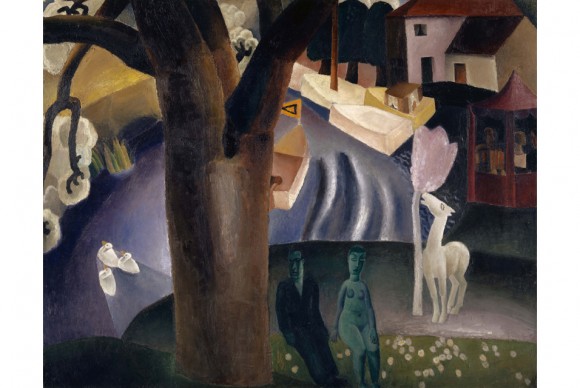Exhibition of Flemish Expressionism from the Emanuel Hoffmann Foundation on view in Basel
February 17, 2014 by All Art News
Filed under Art Events & Exhibitions, Featured
BASEL.- The Flemish Expressionists are a heterogeneous group of artists who created their most important work in Belgium between 1920 and 1930. Their art is informed by their close study of French Cubism and German Expressionism. The majority of the almost twenty works by artists including Frits van den Berghe, Constant Permeke, and Gustaaf de Smet on display in the exhibition are drawn from the holdings of the Emanuel Hoffmann Foundation, with additional works from the Öffentliche Kunstsammlung Basel.
Located on the banks of the river Leie (Lys) on the outskirts of Ghent in East Flanders, the artists’ village of Sint-Martens-Latem is regarded as the birthplace of Flemish Expressionism. During the first decade of the twentieth century, three artists congregate here who will later be the movement’s central protagonists: Frits van den Berghe, Constant Permeke, and Gustaaf de Smet, who first met at the Ghent Academy of Art, come to live and work in the countryside during the summer months. With several others, they form what is known as the second group of the Latemse School, committed to Luminism, a subtly nuanced post-Impressionist style mostly practiced in Belgium and the Netherlands.
The outbreak of World War I and the occupation of the country by German troops bring an abrupt end to the rural idyll. Like many other Belgians, the artists of Latem flee into exile in neighboring countries. Under the powerful impression of the international contemporary art of the time, they gradually move beyond post-Impressionist painting. Their engagement with Cubism, Fauvism, Futurism, and German Expressionism during the war years leads them to develop a range of expressive visual languages clearly informed by the new conceptions of space, shape, and color. As the war ends, the expatriates return to their native country, and in the 1920s, the influential galleries Sélection and Le Centaure in Brussels champion their art. The works of the Flemish Expressionists share a distinct underlying tendency, though they manifest it in different ways: their paintings, figurative throughout, are defined by sculptural volumes, severely reduced forms, and vigorous colors. The figure painting is the artists’ preferred format, although they also work in other traditional genres such as the landscape and the still life.
By holding this focus exhibition, the Kunstmuseum Basel seeks to highlight an aspect of European art history that has tended to fade into obscurity outside the artists’ native Belgium.
Within the Emanuel Hoffmann Foundation, however, artists like Frits van den Berghe, Constant Permeke, and Gustaaf de Smet have always occupied a special position: its holdings of Flemish Expressionist art—complemented in the exhibition by several works from the Öffentliche Kunstsammlung Basel—date from the earliest years of Emanuel and Maja Hoffmann-Stehlin’s collecting activities in the 1920s, when Emanuel Hoffmann directed the establishment of a subsidiary of his father’s chemical and pharmaceutical business in Brussels. During the five years they spent in Belgium, the Hoffmanns, guided by their neighbor Walter Schwarzenberg, who headed the gallery Le Centaure, came to admire the art of the Flemish Expressionists and drew them into their social circle. These works were among the first the couple acquired and are now among the core holdings of the foundation.

